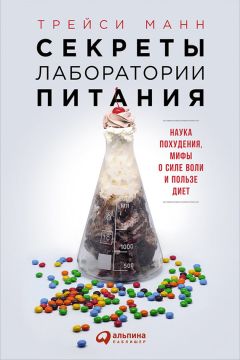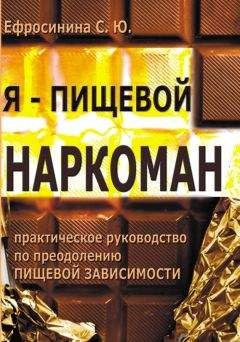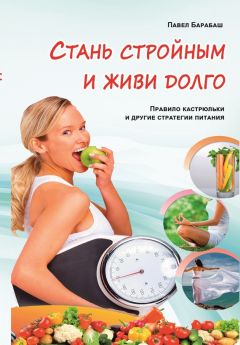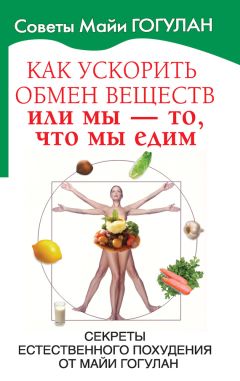Трейси Манн - Секреты лаборатории питания. Наука похудения, мифы о силе воли и пользе диет
35. Sheldon Cohen, David A. Tyrrell, and Andrew P. Smith, “Psychological Stress and Susceptibility to the Common Cold”, New England Journal of Medicine 325, no. 9 (1991): 606-12.
36. Jessica Walburn et al., “Psychological Stress and Wound Healing in Humans: A Systematic Review and Meta-Analysis”, Journal of Psychosomatic Research 67, no. 3 (September 2009): 253-71, doi: 10.1016/j.jpsychores.2009.04.002.
37. Elissa S. Epel et al., “Accelerated Telomere Shortening in Response to Life Stress”, Proceedings of the National Academy of Sciences of the United States of America 101, no. 49 (December 7, 2004): 17312-15, doi: 10.1073/pnas.0407162101.
38. Kimberly A. Brownley et al., “Sympathoadrenergic Mechanisms in Reduced Hemodynamic Stress Responses After Exercise”, Medicine and Science in Sports and Exercise 35, no. 6 (June 2003): 978-86, doi:10.1249/01.MSS.0000069335.12756.1B.
39. Peter Salmon, “Effects of Physical Exercise on Anxiety, Depression, and Sensitivity to Stress”, Clinical Psychology Review 21, no. 1 (February 2001): 33-61, doi:10.1016/S0272-7358(99)00032-X.
40. Cheryl J. Hansen, Larry C. Stevens, and J. Richard Coast, “Exercise Duration and Mood State: How Much Is Enough to Feel Better?”, Health Psychology 20, no. 4 (July 1, 2001): 267-75, doi: 10.1037/0278-6133.20.4.267.
41. J. C. Coulson, J. McKenna, and M. Field, “Exercising at Work and Self-Reported Work Performance”, International Journal of Workplace Health Management 1, no. 3 (September 26, 2008): 176-97, doi: 10.1108/17538350810926534; Robert R. Yeung, “The Acute Effects of Exercise on Mood State”, Journal of Psychosomatic Research 40, no. 2 (February 1996): 123-41, doi: 10.1016/0022-3999(95)00554-4.
42. Salmon, “Effects of Physical Exercise on Anxiety, Depression, and Sensitivity to Stress”.
43. Steven J. Petruzzello et al., “A Meta-Analysis on the Anxiety-Reducing Effects of Acute and Chronic Exercise”, Sports Medicine 11, no. 3 (March 1991): 143-82, doi: 10.2165/00007256-199111030-00002.
44. Peter J. Carek, Sarah E. Laibstain, and Stephen M. Carek, “Exercise for the Treatment of Depression and Anxiety”, International Journal of Psychiatry in Medicine 41, no. 1 (January 1, 2011): 15-28, doi:10.2190/ PM.41.1.c; Andreas Broocks et al., “Comparison of Aerobic Exercise, Clomipramine, and Placebo in the Treatment of Panic Disorder”, American Journal of Psychiatry 155, no. 5 (May 1, 1998): 603-9.
45. Carek, Laibstain, and Carek, “Exercise for the Treatment of Depression and Anxiety”; Gillian E. Mead et al., “Exercise for Depression”, Cochrane Database of Systematic Reviews no. 4 (January 2008): CD004366, doi: 10.1002/14651858.CD004366.pub3.
46. Hamer, Lavoie, and Bacon, “Taking Up Physical Activity in Later Life and Healthy Ageing”.
47. Daniel Y. T. Fong et al., “Physical Activity for Cancer Survivors: Meta-Analysis of Randomised Controlled Trials”, BMJ (Clinical Research Ed.) 344, no. jan30_5 (January 31, 2012): e70, doi: 10.1136/bmj.e70.
48. M. E. Hopkins et al., “Differential Effects of Acute and Regular Physical Exercise on Cognition and Affect”, Neuroscience 215 (July 26, 2012): 59-68, doi:10.1016/j.neuroscience.2012.04.056; Hamer, Lavoie, and Bacon, “Taking Up Physical Activity in Later Life and Healthy Ageing”; Maria A. I. Aberg et al., “Cardiovascular Fitness Is Associated with Cognition in Young Adulthood”, Proceedings of the National Academy of Sciences of the United States of America 106, no. 49 (December 8, 2009): 20906-11, doi:10.1073/pnas.0905307106; Arthur F. Kramer, Kirk I. Erickson, and Stanley J. Colcombe, “Exercise, Cognition, and the Aging Brain”, Journal of Applied Physiology 101, no. 4 (October 1, 2006): 1237-42, doi:10.1152/japplphysiol.00500.2006.
49. Kate Lambourne and Phillip Tomporowski, “The Effect of Exercise-Induced Arousal on Cognitive Task Performance: A Meta-Regression Analysis”, Brain Research 1341 (June 23, 2010): 12-24, doi:10.1016/j. brainres.2010.03.091.
50. Marily Oppezzo and Daniel L. Schwartz, “Give Your Ideas Some Legs: The Positive Effect of Walking on Creative Thinking”, Journal of Experimental Psychology (2014).
51. Shelley S. Tworoger et al., “Effects of a Yearlong Moderate-Intensity Exercise and a Stretching Intervention on Sleep Quality in Postmenopausal Women”, Sleep 26, no. 7 (2003): 830-38.
52. Abby C. King et al., “Moderate-Intensity Exercise and Self-Rated Quality of Sleep in Older Adults”, JAMA 277, no. 1 (January 1, 1997): 32-37, doi: 10.1001/jama. 1997.03540250040029.
53. В этой работе не учитывается масса тела и ее изменения. Hamer, Lavoie, and Bacon, “Taking Up Physical Activity in Later Life and Healthy Ageing”.
54. B. L. Tracy et al., “Muscle Quality. II. Effects of Strength Training in 65-to 75-Yr-Old Men and Women”, Journal of Applied Physiology 86, no. 1 (January 1, 1999): 195-201.
55. Kramer, Erickson, and Colcombe, “Exercise, Cognition, and the Aging Brain”.
56. U.S. Department of Health and Human Services, “2008 Physical Activity Guidelines for Americans”.
57. Подсчитать максимальный пульс можно на веб-сайте по адресу: http://www.ntnu.edu/cerg/hrmax.
58. Karissa L. Canning et al., “Individuals Underestimate Moderate and Vigorous Intensity Physical Activity”, ed. Conrad P. Earnest, PloS One 9, no. 5 (January 2014): e97927, doi:10.1371/journal.pone.0097927.
59. U.S. Department of Health and Human Services,“2008 Physical Activity Guidelines for Americans”.
60. Ross C. Brownson, Tegan K. Boehmer, and Douglas A. Luke, “Declining Rates of Physical Activity in the United States: What Are the Contributors?”, Annual Review of Public Health 26 (October 7, 2005): 421-43.
61. Там же.
62. Там же.
63. Uri Ladabaum et al., “Obesity, Abdominal Obesity, Physical Activity, and Caloric Intake in US Adults: 1988 to 2010”, American Journal of Medicine 127, no. 8 (August 2014): 717-727.el2, doi:10.1016/j. amjmed.2014.02.026.
64. Цель программы «Упражнение — это лекарство» — популяризация упражнений наряду с другими способами профилактики заболеваний, а также учет степени физической активности пациентов при их приеме. 11рограмма поддерживается сотнями организаций, связанных со здравоохранением. Список организаций доступен по ссылке: http://www.cxerciseismedicine.org/supporters.htm.
65. Susan A. Carlson cl al., “Trend and Prevalence Estimates Based on the 2008 Physical Activity Guidelines for Americans”, American Journal of Preventive Medicine 89, no. 4 (October 2010): 305-13, doi:10.1016/j. amepre.2() 10.06.006.
66. Jared M. Uickci, Gregory J. Welk, and Nicholas K. Beyler, “Physical Activity in U.S.: Adults Compliance with the Physical Activity Guidelines for Americans”, American Journal of Preventive Medicine 40, no. 4 (April 2011): 454-61, doi:10.1016/j.amepre.2010.12.016.
67. Там же.
68. Там же. Акселерометры — решение неидеальное, с их помощью можно скорее недооценить интенсивность упражнений, чем переоценить.
69. Ryan Е. Rhodes and Gert-Jan de Bruijn, “How Big Is the Physical Activity Intention-Behaviour Gap? A Meta-Analysis Using the Action Control Framework”, British Journal of Health Psychology 18, no. 2 (May 2013): 296-309, doi: 10.1111 /bjhp. 12032.
70. Geoff Williams, “The Heavy Price of Losing Weight”, U.S. News & World Report, January 2, 2013, http://money.usnews.com/money/ personal-finance/articles/2013/01/02/the-heavy-price-of-losing-weight. Уильямс цитирует этот источник: “Gym Membership Statistics”, StatisticsBrain.com, 2012, http://www.statisticbrain.com/ gym-membership-statistics/.
71. В соответствии с данными sportsbusinessdaily.com, в Соединенных Штатах на спортивную одежду ежегодно тратится $30 млрд: Amber Good fellow, “The Athletic Apparel Industry: Fitness or Fashion?”, Digital Universe, 2013, http://universe.byu.edu/2013/07/30/the-athletic-apparel-industry-fitness-or-fashion/.
72. На эту тему написано множество книг и тысячи статей. Основные идеи в конспективном виде можно найти в книге: Mark Conner et al., Predicting Health Behaviour (Maidenhead, England: McGraw-Hill International, 2005). Еще одну полезную статью см.: Ralf Schwarzer, “Modeling Health Behavior Change: How to Predict and Modify the Adoption and Maintenance of Health Behaviors”, Applied Psychology 57, no. 1 (January 2008): 1-29, doi:10.1111/j.l464-0597.2007.00325.x.
73. Conner et al., “Predicting Health Behaviour”.
74. Marcel den Hoed et al., “Heritability of Objectively Assessed Daily Physical Activity and Sedentary Behavior”, American Journal of Clinical Nutrition 98, no. 5 (November 18, 2013): 1317-25, doi:10.3945/ ajcn.113.069849.
75. Justin S. Rhodes, Theodore Garland, and Stephen C. Gammie, “Patterns of Brain Activity Associated with Variation in Voluntary Wheel-Running Behavior”, Behavioral Neuroscience 117, no. 6 (December 1, 2003): 1243-56, doi: 10.1037/0735-7044.117.6.1243.
76. Там же.
77. Rachel J. Burns et al., “A Theoretically Grounded Systematic Review of Material Incentives for Weight Loss: Implications for Interventions”, Annals of Behavioral Medicine 44, no. 3 (December 2012): 375-88, doi: 10.1007/S12160-012-9403-4.
78. Этой студенткой была Рейчел Бернс.
79. Rachel J. Burns, “Can We Pay People to Act Healthily? Testing the Relative Effectiveness of Incentive Dimensions and Underlying Psychological Mediators” (University of Minnesota, 2014).
80. He у меня одной был такой опыт. Бенджамин Лорр в своей книге описывает нечто подобное (хотя и более подробно). Benjamin Lorr, “Hell-Bent: Obsession, Pain, and the Search for Something Like Transcendence in Competitive Yoga” (New York: St. Martin’s Press, 2012).
81. О том, как важно, чтобы поощрение было немедленным, см.: С. В. Ferster and В. F. Skinner, “Schedules of Reinforcement” (East Norwalk, CT: Appleton-Century-Crofts, 1957). Мне на глаза не попадалось научных доказательств, что на регулярность тренировок в течение длительного периода в большей степени влияет повышение уровня физической подготовки, нежели успехи в похудении. Я работаю над исследованием этого вопроса.
82. Carolina О. С. Werle, Brian Wansink, and Collin R. Payne, “Is It Fun or Exercise? The Framing of Physical Activity Biases Subsequent Snacking”, Marketing Letters (May 15, 2014), doi: 10.1007/sl 1002-014-9301-6.
83. Staub, “Instigation to Goodness”; Howland, Hunger, and Mann, “Friends Don’t Let Friends Eat Cookies”.
84. Staub, “Instigation to Goodness”; Howland, Hunger, and Mann, “Friends Don’t Let Friends Eat Cookies”.
85. Gollwitzer and Sheeran, “Implementation Intentions and Goal Achievement”.
86. Sarah Milne, Sheina Orbell, and Paschal Sheeran, “Combining Motivational and Volitional Interventions to Promote Exercise Participation:
Protection Motivation Theory and Implementation Intentions”, British Journal of Health Psychology 7, no. Pt 2 (May 2002): 163-84, doi: 10.1348/135910702169420.
87. Там же.
88. Gollwitzer and Slice ran, “Implementation Intentions and Goal Achievement”.
89. Williams, “The I lenvy Price of Losing Weight”.
90. Schwartz et al., “Healthier by Precommitment”.
91. E. Kahn et al., “The Effectiveness of Interventions to Increase Physical Activity: A Systematic Review”, American Journal of Preventive Medicine 22, no. 4 (May 2002): 73-107, doi:10.1016/S0749-3797(02)00434-8; G. Neil Thomas et al., “I lealth Promotion in Older Chinese: A 12-Month Cluster Randomized Controlled Trial of Pedometry and ‘Peer Support”’, Medicine and Science in Sports and Exercise 44, no. 6 (June 2012): 1157-66, doi: 10.1249/MSS.0b013e318244314a.
ЗАКЛЮЧИТЕЛЬНЫЕ СЛОВА: ЕСТЬ ДИЕТА - СМЫСЛА НЕТ1. Tomiyama et al., “Low Calorie Dieting Increases Cortisol”.
2. Glennon Doyle Melton, “Your Body Is Not Your Masterpiece”, Momastery blog, July 6, 2014, http://momastery.com/blog/2014/07/06/body-masterpiece/.
Об авторе
Трейси Манн — профессор социальной психологии и психологии здоровья Миннесотского университета. Докторскую степень в области психологии получила в Стэнфордском университете, преподавала в Калифорнийском университете, а затем в 2007 г. перешла в Миннесотский университет, где основала Лабораторию здоровья и питания. Ее исследования спонсируют национальные институты здравоохранения США, министерство сельского хозяйства США, NASA. Вместе с мужем Стивеном Энгелем, профессором психологии, также работающим в Миннесотском университете, и двумя сыновьями живет в городе Эдина штата Миннесота.
Примечания
1
Одна из крупнейших ярмарок в США, на которой демонстрируются сельскохозяйственные достижения. Посетители ярмарки могут продегустировать разнообразные блюда, посмотреть представления музыкальных и танцевальных коллективов и покататься на аттракционах. — Прим. пер. (Все последующие примечания, не обозначенные пометой Прим. ред., принадлежат переводчику.)




